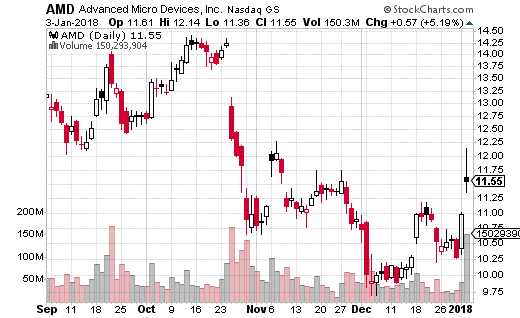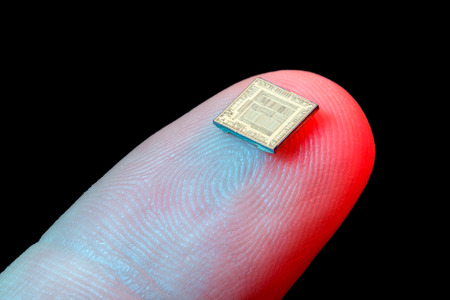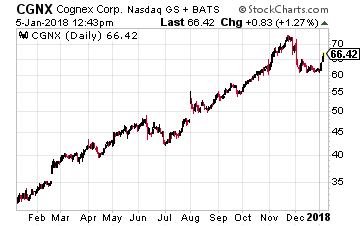It’s only the first week of the New Year, and there’s already plenty going on in the financial markets. While there hasn’t been much in the way of volatility, that’s only because stocks are mostly going up. In that sense, 2018 is acting much like 2017.
On the other hand, one major stock that isn’t going up is Intel (NASDAQ: INTC). In fact, it’s quite the opposite situation. As of this writing, INTC was down 5% to kick off 2018.
Here’s the deal…
News broke this week of a potential design flaw in Intel processors which could pose a security risk. Moreover, the fix (patch) for the flaw allegedly slows down the performance of the chips by as much as 30%. This flaw supposedly only impacts Intel chips and not its competitors.
You can see why this would be very bad news for the company. Not only will it likely push consumers to other chip producers, but it also will open up lawsuits or expensive fixes/replacements for Intel. It’s clearly the reason why INTC stock is down and competitors like Advanced Micro Devices (NASDAQ: AMD) and NVIDIA (NASDAQ: NVDA) are up.
Intel hasn’t denied the existence of the flaw, although the company says it will impact multiple types of chips across various devices and is not just an Intel-specific issue. Regardless, with INTC controlling 80% of the microprocessor market, it will certainly be hit the hardest.
This scenario is also playing out in the options market, where AMD is seeing quite a bit of bullish options activity. The day the news hit the wire, about 80% of the money going into AMD options was of the bullish variety. (About 125,000 more options contracts traded that day than what’s average in the stock.)
One trade which caught my eye was a purchase of over 1,500 April 12 calls with AMD trading around $11.75. The buyer paid $1.20, which means AMD needs to get to $13.20 by April expiration for the trade to break even.
The call buyer is spending over $175,000 on these contracts, so there clearly is some belief that AMD is going to keep going up. Over the last 52 weeks, AMD has been as high as $15.65, so it’s definitely not out of the realm of possibility that the stock runs quite a bit higher.

It will be interesting to see if the exuberance around AMD’s prospects diminishes once the news sinks in a bit more. As you can see from the chart, the stock already came back down to earth somewhat the same day it spiked higher.
If you believe AMD is ripe for a move higher, but you don’t want to drop $1.20 on 3 month calls, you could buy a call spread. That’s when you purchase a lower strike call, such as the 12, and sell a higher call, like the 14, to save money on the position.
An April 12-14 call spread like I just described only costs about $0.60, or half the cost of the straight call purchase. Your upside is limited to $1.40 because of the short 14 strike and the $0.60 cost of the trade. But, you are spending a whole lot less on the position. Plus, spending $0.60 for the chance to make $1.40 is not a bad payout ratio at all.
This simple strategy can easily add thousands of dollars of income to your savings over the next 6 months, and I want to show you step-by-step how to do it in your portfolio.
[FREE REPORT] Options Income Blueprint: 3 Proven Strategies to Earn More Cash Today Discover how to grab $577 to $2,175 every 7 days even if you have a small brokerage account or little experience... And it's as simple as using these 3 proven trading strategies for earning extra cash. They’re revealed in my new ebook, Options Income Blueprint: 3 Proven Strategies to Earn Extra Cash Today. You can get it right now absolutely FREE. Click here right now for your free copy and to start pulling in up to $2,175 in extra income every week.
Source: Investors Alley


 Foremost in this sector is Cognex (Nasdaq: CGNX), which is the leader globally in providing vision systems, vision software, vision sensors and industrial ID readers. It sells its vision systems to most of the big players in the industrial robotics industry including ABB, Yaskawa Electric and Germany’s Kuka AG. The only exception is Fanuc, which makes its own vision systems. This translates to Cognex having a 30% share of the vision systems market.
Foremost in this sector is Cognex (Nasdaq: CGNX), which is the leader globally in providing vision systems, vision software, vision sensors and industrial ID readers. It sells its vision systems to most of the big players in the industrial robotics industry including ABB, Yaskawa Electric and Germany’s Kuka AG. The only exception is Fanuc, which makes its own vision systems. This translates to Cognex having a 30% share of the vision systems market.